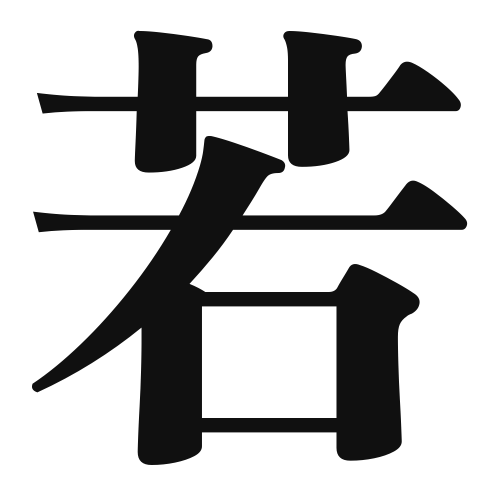1. Overview of Meaning
The kanji “若” (pronounced “waka” or “naka”) generally means “young” or “to seem.” It is often used to describe youthfulness or a state of being in the early stages of life or development.
2. Formation and Radical
Formation of the Kanji: The kanji “若” is classified as a phonetic-ideographic character (形声文字). It combines the meaning of youthfulness with phonetic elements that suggest its pronunciation.
Radical: The radical for “若” is “衣” (clothing), which is found at the bottom of the character. This radical often relates to clothing or appearance, linking to the idea of youth and freshness.
3. Examples of Usage
Common Words and Phrases:
- 若者 (wakamono) – young person
- 若い (wakai) – young
- 若干 (jakkan) – somewhat, a little
Example Sentences in Daily Conversation:
- 彼は若いです。 (Kare wa wakai desu.) – He is young.
- 若者たちが集まっています。 (Wakamonotachi ga atsumatteimasu.) – Young people are gathering.
4. Synonyms and Antonyms
Similar Kanji:
- 幼 (you) – meaning “infant” or “child,” which refers to a younger stage than “若.”
- 青春 (seishun) – meaning “youth,” which encompasses a broader concept of young adulthood.
Antonyms:
- 老 (rou) – meaning “old,” which is the opposite of “young.”
- 成熟 (seijuku) – meaning “mature,” indicating a fully developed state.
5. Cultural and Historical Background
Relation to Japanese Culture: The concept of youth is highly valued in Japanese culture, often associated with vitality and potential. The kanji “若” is frequently used in literature and poetry to evoke feelings of nostalgia and the fleeting nature of youth.
Proverbs and Idioms:
- 若い時の苦労は買ってでもせよ (Wakai toki no kurou wa katte demo seyo) – “Endure hardships in youth, even if you have to buy them.” This proverb emphasizes the importance of learning and growing through challenges during one’s younger years.
